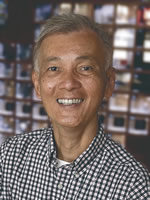 Lawrence Que, Jr. received his BS degree in Chemistry from Ateneo de Manila University in 1969 and PhD degree in Chemistry from University of Minnesota in 1973. After postdoctoral studies, one with Professor Richard H. Holm at Massachusetts Institute of Technology (1973-74) and another with Eckard Münck at Gray Freshwater Biological Institute (1975-77), Professor Que started his independent career as an Assistant Professor of Chemistry at Cornell University in 1977. In 1983, Professor Que moved to the University of Minnesota as an Associate Professor of Chemistry. He is now a Regents Professor of the University of Minnesota and the 3M/Alumni Distinguished Professor of Chemistry.
Lawrence Que, Jr. received his BS degree in Chemistry from Ateneo de Manila University in 1969 and PhD degree in Chemistry from University of Minnesota in 1973. After postdoctoral studies, one with Professor Richard H. Holm at Massachusetts Institute of Technology (1973-74) and another with Eckard Münck at Gray Freshwater Biological Institute (1975-77), Professor Que started his independent career as an Assistant Professor of Chemistry at Cornell University in 1977. In 1983, Professor Que moved to the University of Minnesota as an Associate Professor of Chemistry. He is now a Regents Professor of the University of Minnesota and the 3M/Alumni Distinguished Professor of Chemistry.
Professor Que has played a pioneering role in understanding how nonheme iron centers in biology activate O2 to carry out a diverse array of metabolically important reactions. In general, O2 activation is thought to involve high-valent iron-oxo intermediates, and Que’s biomimetic efforts have produced the first synthetic precedents for such enzymatic intermediates. These well-characterized complexes provide benchmarks for understanding the electronic structures, spectroscopic properties, and reactivities of the iron(IV)-oxo unit. Furthermore, Que has been a leader in efforts to design functional models for iron oxygenases, obtaining the first biomimetic examples for catechol dioxygenases, α-ketoglutarate-dependent oxygenases, and cis-dihydroxylating arene dioxygenases. This latter endeavor has led to the development of bio-inspired nonheme iron catalysts capable of stereospecific alkane hydroxylation and highly enantioselective olefin cis-dihydroxylation. Such iron catalysts may lead to “greener” and sustainable alternatives to currently used heavy-metal oxidation catalysts.
Professor Que has published more than 450 papers and the holder of seven patents. He is the Chief Editor of Journal of Biological Inorganic Chemistry, the flagship journal of the Society of Biological Inorganic Chemistry. For his contributions, Professor Que has won numerous awards and honors, including the Alfred P. Sloan Research Fellowship (1982-86), the NIH Research Career Development Award (1982-87), the National Institutes of Health MERIT Award (2000-2010), the Frontiers in Biological Chemistry Award from the Max-Planck-Institut für Bioanorganishe Chemie (2005), the Japan Society for the Promotion of Science Lecturer (2006), the American Chemical Society Alfred Bader Award in Bioorganic or Bioinorganic Chemistry (2008), and the Royal Society of Chemistry Inorganic Mechanisms Award (2011). He is also a Fellow of the American Association for the Advancement of Science (2001), a Fellow of the Royal Society of Chemistry (2008), and an ACS Fellow (2011).